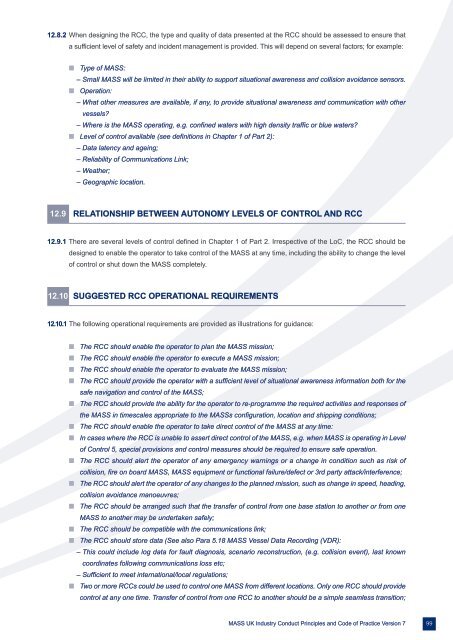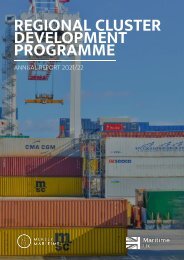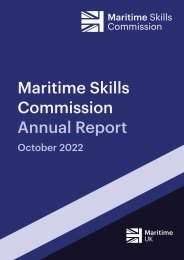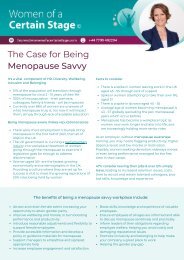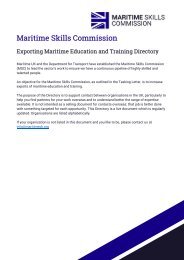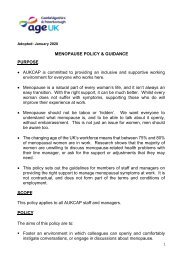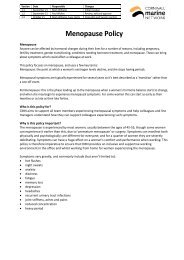COP_2023_V7_pages
You also want an ePaper? Increase the reach of your titles
YUMPU automatically turns print PDFs into web optimized ePapers that Google loves.
12.8.2 When designing the RCC, the type and quality of data presented at the RCC should be assessed to ensure that<br />
a sufficient level of safety and incident management is provided. This will depend on several factors; for example:<br />
n Type of MASS:<br />
– Small MASS will be limited in their ability to support situational awareness and collision avoidance sensors.<br />
n Operation:<br />
– What other measures are available, if any, to provide situational awareness and communication with other<br />
vessels?<br />
– Where is the MASS operating, e.g. confined waters with high density traffic or blue waters?<br />
n Level of control available (see definitions in Chapter 1 of Part 2):<br />
– Data latency and ageing;<br />
– Reliability of Communications Link;<br />
– Weather;<br />
– Geographic location.<br />
12.9 RELATIONSHIP BETWEEN AUTONOMY LEVELS OF CONTROL AND RCC<br />
12.9.1 There are several levels of control defined in Chapter 1 of Part 2. Irrespective of the LoC, the RCC should be<br />
designed to enable the operator to take control of the MASS at any time, including the ability to change the level<br />
of control or shut down the MASS completely.<br />
12.10 SUGGESTED RCC OPERATIONAL REQUIREMENTS<br />
12.10.1 The following operational requirements are provided as illustrations for guidance:<br />
n The RCC should enable the operator to plan the MASS mission;<br />
n The RCC should enable the operator to execute a MASS mission;<br />
n The RCC should enable the operator to evaluate the MASS mission;<br />
n The RCC should provide the operator with a sufficient level of situational awareness information both for the<br />
safe navigation and control of the MASS;<br />
n The RCC should provide the ability for the operator to re-programme the required activities and responses of<br />
the MASS in timescales appropriate to the MASSs configuration, location and shipping conditions;<br />
n The RCC should enable the operator to take direct control of the MASS at any time:<br />
n In cases where the RCC is unable to assert direct control of the MASS, e.g. when MASS is operating in Level<br />
of Control 5, special provisions and control measures should be required to ensure safe operation.<br />
n The RCC should alert the operator of any emergency warnings or a change in condition such as risk of<br />
collision, fire on board MASS, MASS equipment or functional failure/defect or 3rd party attack/interference;<br />
n The RCC should alert the operator of any changes to the planned mission, such as change in speed, heading,<br />
collision avoidance manoeuvres;<br />
n The RCC should be arranged such that the transfer of control from one base station to another or from one<br />
MASS to another may be undertaken safely;<br />
n The RCC should be compatible with the communications link;<br />
n The RCC should store data (See also Para 5.18 MASS Vessel Data Recording (VDR):<br />
– This could include log data for fault diagnosis, scenario reconstruction, (e.g. collision event), last known<br />
coordinates following communications loss etc;<br />
– Sufficient to meet international/local regulations;<br />
n Two or more RCCs could be used to control one MASS from different locations. Only one RCC should provide<br />
control at any one time. Transfer of control from one RCC to another should be a simple seamless transition;<br />
MASS UK Industry Conduct Principles and Code of Practice Version 7<br />
99


